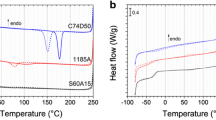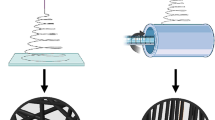Abstract
Electrically conducting textile fibers were produced by wet-spinning under various volume fractions using thermoplastic polyurethane (TPU) as a polymer and carbon black (CB), Ag-powder, multi-walled carbon nanotubes (MWCNTs), which are widely used as electrically conducting nanofillers. After applying the fiber to the heat drawing process at different draw ratios, the filler volume fraction, linear density, breaking to strength, and electrical conductivity according to each draw ratio and volume fraction. In addition, scanning electron microscopy (SEM) images were taken. The breaking to strength of the TPU fiber containing the nanofillers increased with increasing draw ratio. At a draw ratio of 2.5, the breaking to strength of the TPU fiber increased by 105 % for neat-TPU, 88 % for CB, 86 % for Ag-powder, and 127 % for MWCNT compared to the undrawn fiber. The breaking to strength of the TPU fiber containing CB decreased gradually with increasing volume fraction, and in case of Ag-powder, it decreased sharply owing to its specific gravity. The electrical conductivity of the TPU fiber containing CB and Ag-powder decreased with increasing draw ratio, but the electrical conductivity of the TPU fiber containing MWCNT increased rapidly after the addition of 1.34 vol. % or over. The moment when the aggregation of MWCNT occurred and its breaking to strength started to decrease was determined to be the percolation threshold of the electrical conductivity. The heat drawing process of the fiber-form material containing the anisotropic electrical conductivity nanofillers make the percolation threshold of the electrical conductivity and the maximum breaking to strength appear at a lower volume fraction. This is effective in the development of a breaking to strength and electrical conductivity.
Similar content being viewed by others
References
E. Bilotti, H. Zhang, H. Deng, R. Zhang, Q. Fu, and T. Peijs, Compos. Sci. Technol., 74, 85 (2013).
E. Bilotti, R. Zhang, H. Deng, M. Baxendale, and T. Peijs, J. Mater. Chem., 20, 9449 (2010).
S. Razdan, P. K. Patra, S. Kar, L. Ci, R. Vajtai, A. Kukovecz, Z. Konya, L. Kiricsi, and P. Ajayan, Chem. Mater., 21, 3062 (2009).
T. W. Chou and E. T. Thostenson, Adv. Mater., 18, 2837 (2006).
O. Meincke, D. Kaempfer, H. Weickmann, C. Friedrich, M. Vathauer, and H. Warth, Polymer, 45, 739 (2004).
H. D. Bao, Z. X. Guo, and J. Yu, Polymer, 49, 3826 (2008).
H. Deng, R. Zhang, C. T. Reynolds, E. Bilotti, and T. Peijs, Macromol. Mater. Eng., 294, 749 (2009).
M. Park, H. Kim, and J. P. Youngblood, Nanotechnology, 19, 055705 (2008).
J. Shen, M. F. Champagne, R. Gendron, and S. Guo, Eur. Polym. J., 48, 930 (2012).
F. M. Blighe, K. Young, J. J. Vilatela, A. H. Windle, I. A. Kinloch, L. Deng, R. J. Young, and J. N. Coleman, Adv. Funct. Mater., 21, 364 (2011).
J. Chen, X. C. Du, W. B. Zhang, J. H. Yang, N. Zhang, T. Huang, and Y. Wang, Compos. Sci. Technol., 81, 1 (2013).
M. Narkis, E. Segal, and R. Tchoudakov, Polym. Eng. Sci., 42, 2430 (2002).
H. Yang, J. Gong, X. Wen, J. Xue, Q. Chen, Z. Jiang, N. Tian, and T. Tang, Compos. Sci. Technol., 113, 31 (2015).
S. D. A. S. Ramoa, G. M. O. Barra, R. V. B. Oliveira, M. G. de Oliveira, M. Cossa, and B. G. Soares, Polym. Int., 62, 1477 (2013).
J. Sumfleth, X. C. Adroher, and K. Schulte, J. Mater. Sci., 44, 3241 (2009).
I. Novak, L. Krupa, and I. Chodak, Synth. Met., 144, 13 (2011).
M. H. Al-Saleh and U. Sundararaj, Carbon, 47, 2 (2009).
B. Marinho, M. Ghislandi, E. Tkalya, C. E. Koning, and G. D. With, Powder Technol., 221, 351 (2012).
S. Kwon, R. Ma, U. Kim, H. R. Choi, and S. Baik, Carbon, 68, 118 (2014).
J. Xiong, Z. Zheng, X. Qin, M. Li, H. Li, and X. Wang, Carbon, 44, 2701 (2006).
H. Koerner, W. Liu, M. Alexander, P. Mirau, H. Dowty, and R. A. Vaia, Polymer, 46, 4405 (2005).
W. Chen, X. Tao, and Y. Liu, Compos. Sci. Technol., 66, 3029 (2006).
D. X. Yan, K. Dai, Z. D. Xiang, Z. M. Li, X. Ji, and W. Q. Zhang, J. Appl. Polym. Sci., 120, 3014 (2011).
Author information
Authors and Affiliations
Corresponding author
Rights and permissions
About this article
Cite this article
Kim, J.W., Lee, J.S. Influence of the draw ratio on the mechanical properties and electrical conductivity of nanofilled thermoplastic polyurethane fibers. Fibers Polym 18, 81–87 (2017). https://doi.org/10.1007/s12221-017-6387-5
Received:
Revised:
Accepted:
Published:
Issue Date:
DOI: https://doi.org/10.1007/s12221-017-6387-5




